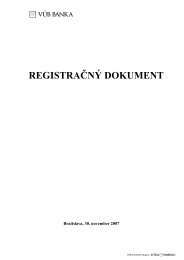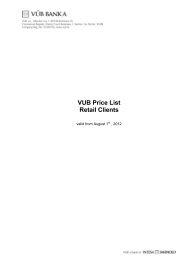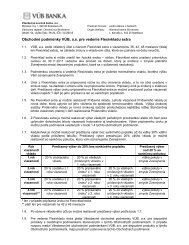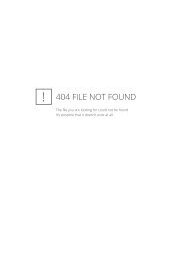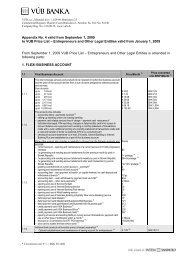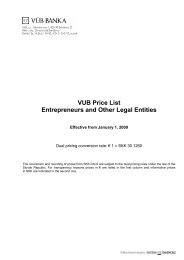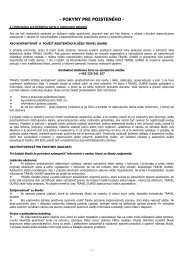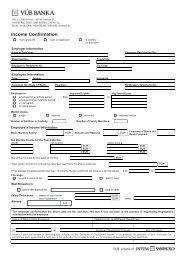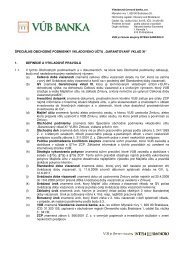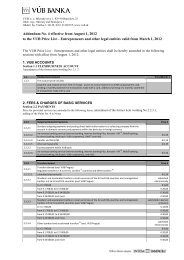Annual Report - VÃB banka
Annual Report - VÃB banka
Annual Report - VÃB banka
Create successful ePaper yourself
Turn your PDF publications into a flip-book with our unique Google optimized e-Paper software.
76<br />
2. Summary of significant accounting policies (continued)<br />
Embedded derivatives<br />
The Bank assesses whether any embedded derivatives<br />
contained in the contract are required to<br />
be separated from the host contract and accounted<br />
for as derivatives under IAS 39. An embedded<br />
derivative is a component of a hybrid (combined)<br />
instrument that also includes a non-derivative host<br />
contract-with the effect that some of the cash fl ows<br />
of the combined instrument vary in a way similar to<br />
a stand-alone derivative.<br />
The Bank accounts for embedded derivatives separately<br />
from the host contract, if: the economic<br />
characteristics and risks of the embedded derivative<br />
are not closely related to the economic<br />
characteristics and risks of the host contract;<br />
a separate instrument with the same terms as the<br />
embedded derivative would meet the defi nition of<br />
a derivative; and the hybrid (combined) instrument<br />
is not measured at fair value with changes in fair<br />
value recognized in profi t or loss.<br />
Hedging derivatives<br />
The Bank makes use of derivative instruments to<br />
manage exposures to interest rate, foreign currency<br />
and credit risks, including exposures arising<br />
from forecast transactions. In order to manage particular<br />
risks, the Bank applies hedge accounting for<br />
transactions which meet the specifi ed criteria.<br />
At the inception of the hedge relationship, the Bank<br />
formally documents the relationship between the<br />
hedged item and the hedging instrument, including<br />
the nature of the risk, the objective and strategy for<br />
undertaking the hedge and the method that will be<br />
used to assess the effectiveness of the hedging relationship.<br />
Also at the inception of the hedge relationship, a<br />
formal assessment is undertaken to ensure the<br />
hedging instrument is expected to be highly effective<br />
in offsetting the designated risk in the hedged<br />
item. Hedges are formally assessed each month. A<br />
hedge is regarded as highly effective if the changes<br />
in fair value or cash fl ows attributable to the<br />
hedged risk during the period for which the hedge<br />
is designated are expected to offset in a range of<br />
80% to 125%. For situations where that hedged<br />
item is a forecast transaction, the Bank assesses<br />
whether the transaction is highly probable and presents<br />
an exposure to variations in cash fl ows that<br />
could ultimately affect the income statement.<br />
Cash fl ow hedges<br />
For designated and qualifying cash fl ow hedges,<br />
the effective portion of the gain or loss on the<br />
hedging instrument is initially recognized directly in<br />
equity in the ‘Hedging reserve’. The ineffective portion<br />
of the gain or loss on the hedging instrument is<br />
recognized immediately in the income statement in<br />
‘Net trading income’.<br />
When the hedged cash fl ow affects the income statement,<br />
the gain or loss on the hedging instrument<br />
is ‘recycled’ in the corresponding income or expense<br />
line of the income statement. When a hedging instrument<br />
expires, or is sold, terminated, exercised,<br />
or when a hedge no longer meets the criteria for<br />
hedge accounting, any cumulative gain or loss existing<br />
in equity at that time remains in equity and is<br />
recognized when the hedged forecast transaction<br />
is ultimately recognized in the income statement.<br />
When a forecast transaction is no longer expected<br />
to occur, the cumulative gain or loss that was reported<br />
in equity is immediately transferred to the<br />
income statement in ‘Net trading income’.<br />
<strong>Annual</strong> <strong>Report</strong> 2007



